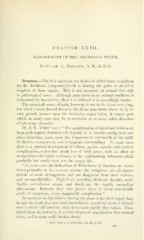Page 665 - My FlipBook
P. 665
CHAPTER XXIII.
MANAGEMENT OF THE DECIDUOUS TEETH.
By Claek L. Goddaed, A. M., D. D. S.
Eruption.—The first operation the dentist is called upon to perform
for the deciduous (temporary) teeth is lancing the gums as an aid to
eruption of those organs. This is not necessary in normal but only
in pathological cases. Although gum tissue in its normal condition is
comi)aratively insensitive, when it is inflamed it is exceedingly tender.
The principal source of pain, however, is not in the tissue overlying,
but when a tooth, bound down by the dense gum tissue above it, by its
own growth presses upon the formative organ below, it causes pain
which in many cases may be so excessive as to cause reflex disorders
of alarming character.
Dr. J. W. White ^ says : " The manifestation of functional inharmony
from pathological dentition will depend, as in trouble arising from any
other disturbing cause, upon the temperament and health of the child,
its dietetic management, and its hygienic surroundings. In some cases
there is a gradual development of biliary, gastric, enteric, and cerebral
complications, a slow but steady loss of vital power, with no effort at
recuperation and feeble resistance to the undermining influences which
gradually but surely wear out the young life.
" In other cases the indications of disturbance of function are mani-
fested primarily in the nervous system : the symptoms are all charac-
teristic of acute derangement and are dangerous from their violence
and uncontrollability. High fever, vomiting, choleraic diarrhea, men-
ingitis, convulsions, stupor and death are the rapidly succeeding
phenomena. Between these two phases there is every conceivable
grade of symptoms, every imaginable complication."
By many, as an objection to lancing the gums it has been urged that,
in case the tooth does not erupt immediately, cicatricial tissue is formed
over it which will bind the tooth down more rigidly than before. Cica-
tricial tissue is, however, of a lower degree of organization than normal
tissue, and is more easily broken down.
^ Amer. System of Dentistry, vol. iii. p. 327.
663


